Matcha
Ultimate Guide to Choosing Ceremonial Grade Tea Powder

Welcome to our ultimate guide to choosing ceremonial grade tea powder!
We understand that selecting the perfect tea powder can be overwhelming, but fear not! We are here to guide you through the process with expertise and mastery.
In this comprehensive guide, we will delve into the world of ceremonial grade matcha, exploring its significance, quality factors, and the traditional Japanese tea ceremony.
We will discuss the importance of color, harvesting and processing methods, and the different grades of matcha.
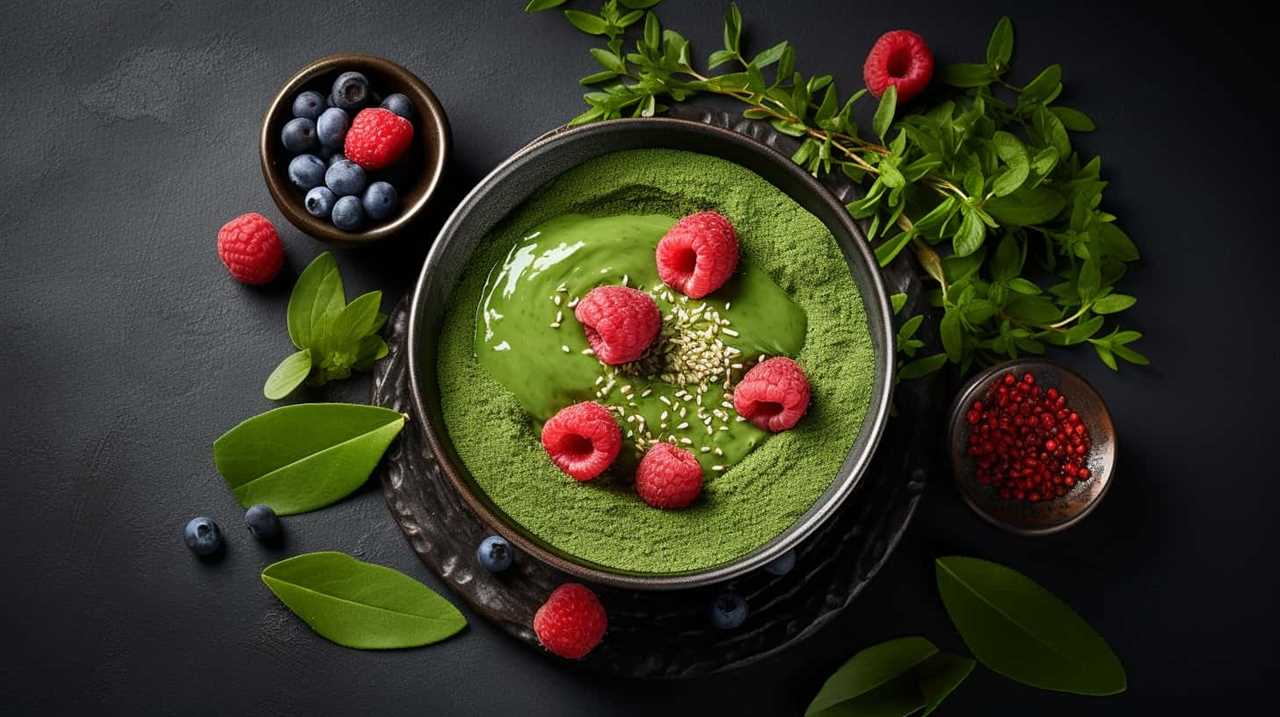
Additionally, we will provide expert recommendations and helpful tips for packaging and storage.
So, whether you’re a tea aficionado or a curious newcomer, let’s embark on this journey together and discover the secrets to finding the finest ceremonial grade tea powder.
Key Takeaways
- Ceremonial grade matcha is a high-quality powdered green tea traditionally used in Japanese tea ceremonies.
- The quality of tea leaves directly impacts the flavor and aroma of the tea.
- Tracing the authenticity and origin of matcha is essential to ensure a genuine product.
- Certifications and quality indicators such as color, aroma, texture, and flavor profile are important when assessing the quality of ceremonial grade matcha.
What Is Ceremonial Grade Matcha
Ceremonial grade matcha is a high-quality powdered green tea that’s traditionally used in Japanese tea ceremonies. It’s known for its vibrant green color and rich, umami flavor. This premium grade of matcha is made from the youngest tea leaves, which are carefully shaded for several weeks before harvesting. The shading process increases the chlorophyll content in the leaves, giving matcha its distinctive color and boosting its health benefits.
Speaking of health benefits, ceremonial grade matcha is packed with antioxidants, vitamins, and minerals. It provides a natural energy boost without the jitters associated with coffee. Matcha also contains L-theanine, an amino acid that promotes relaxation and focus.

Preparing matcha at home is a simple process that requires a few essential tools, such as a bamboo whisk, a matcha bowl, and a sifter. Start by sifting the matcha powder to remove any lumps, then add hot water and whisk vigorously in a zigzag motion until frothy. Enjoy this invigorating beverage and experience the ancient art of Japanese tea ceremonies in the comfort of your own home.
The Importance of Quality Tea Leaves
When it comes to choosing the perfect ceremonial grade tea powder, the quality of the tea leaves becomes of utmost importance. The freshness of the leaves directly impacts the flavor and aroma of the tea, making it crucial to select leaves that are harvested and processed with care. High-quality tea leaves are known to provide numerous health benefits, such as boosting metabolism, improving mental alertness, and enhancing the immune system. To help you understand the significance of quality tea leaves, take a look at the table below:
| Quality Tea Leaves | Importance |
|---|---|
| Freshly harvested | Retains maximum flavor and nutrients |
| Hand-picked | Ensures only the finest leaves are selected |
| Organic | Free from pesticides and harmful chemicals |
Understanding the Traditional Japanese Tea Ceremony
To truly appreciate the beauty and significance of the traditional Japanese tea ceremony, one must immerse themselves in its rich history and cultural traditions. Traditional tea ceremonies have been an integral part of Japanese culture for centuries, embodying principles of harmony, respect, purity, and tranquility. These ceremonies aren’t simply about preparing and drinking tea, but rather they’re a profound spiritual and aesthetic experience.
Every aspect of the ceremony, from the preparation of the tea to the way it’s served and consumed, is carefully choreographed and imbued with deep meaning. The cultural significance of the tea ceremony lies in its ability to foster mindfulness, connect people with nature, and create a space for contemplation and social interaction. Understanding the traditional Japanese tea ceremony is essential for those seeking mastery in the art of tea appreciation.

Transition: Now that we’ve gained insight into the cultural significance of traditional tea ceremonies, let’s explore the factors to consider when buying ceremonial grade matcha.
Factors to Consider When Buying Ceremonial Grade Matcha
When it comes to buying ceremonial grade matcha, there are several factors to consider.
One of the most important is the quality indicators for matcha, such as color, aroma, and texture.
Additionally, authenticity and origin play a crucial role in determining the overall quality of the matcha.

Lastly, it’s important to strike a balance between price and quality, as higher prices don’t always guarantee the best matcha.
Quality Indicators for Matcha
We carefully evaluate various quality indicators when selecting ceremonial grade matcha for purchase. Matcha production plays a crucial role in determining the quality of the tea powder.
Matcha made from shade-grown tea leaves tends to have a sweeter and more vibrant flavor compared to those grown in direct sunlight. Additionally, the health benefits of matcha can also serve as an indicator of its quality. High-quality matcha is known to be rich in antioxidants, amino acids, and chlorophyll, which contribute to its vibrant green color and numerous health benefits.
By considering these factors, we ensure that the matcha we choose is of the highest quality.
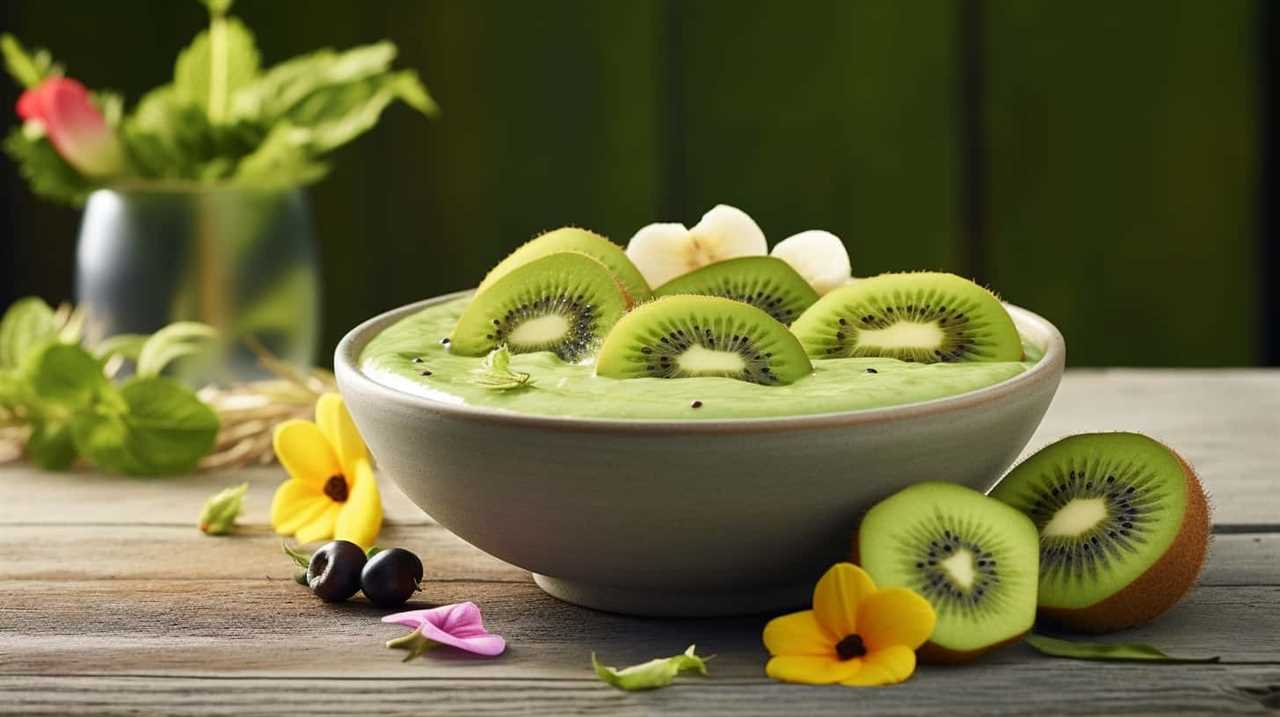
Now, let’s delve into the next section and explore the importance of authenticity and origin in selecting ceremonial grade matcha.
Authenticity and Origin
When selecting ceremonial grade matcha, one crucial factor to consider is the authenticity and origin of the tea powder. Tracing the tea’s authenticity is essential to ensure that you’re getting a genuine product with all the qualities and health benefits that matcha is known for.
Authentic matcha comes from specific regions in Japan, such as Uji, Nishio, and Shizuoka. These regions have a long history of tea cultivation and are known for producing high-quality matcha.
Verifying the tea’s origin is equally important. Look for teas that are certified by reputable organizations like the Japan Tea Export Council or the Kyoto Tea Association. These certifications guarantee that the matcha is sourced from the designated regions and meets the strict quality standards set by these organizations.
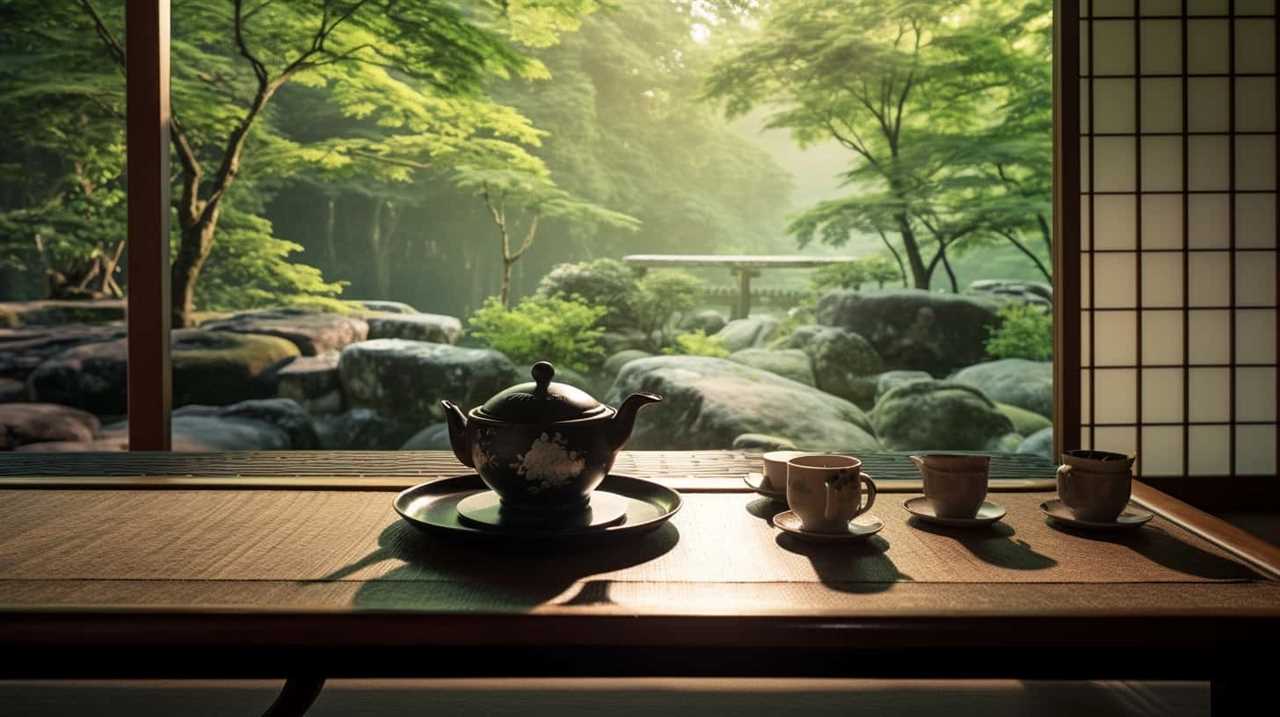
Price Vs. Quality
Considering the balance between price and quality is crucial when purchasing ceremonial grade matcha. As discerning consumers, we want to ensure that we’re getting the best value for our money. When it comes to price comparison, it’s important to note that ceremonial grade matcha tends to be more expensive than lower grades. This is due to the meticulous cultivation and processing methods involved in producing high-quality matcha. However, it’s essential to look beyond the price tag and focus on the overall quality.
Factors such as taste, aroma, and texture should be taken into consideration to determine the true value of the matcha. By prioritizing quality over price, we can ensure a satisfying tea experience.
Now, let’s delve into the role of color in ceremonial grade matcha.
The Role of Color in Ceremonial Grade Matcha
To understand the role of color in ceremonial grade matcha, it is important to delve into the various shades and their significance. In traditional tea ceremonies, the color of matcha holds great cultural significance and is closely tied to the overall aesthetic experience. The hue of the tea powder can indicate its quality, freshness, and even the region it comes from. Below is a table showcasing the different shades of matcha and their meanings:
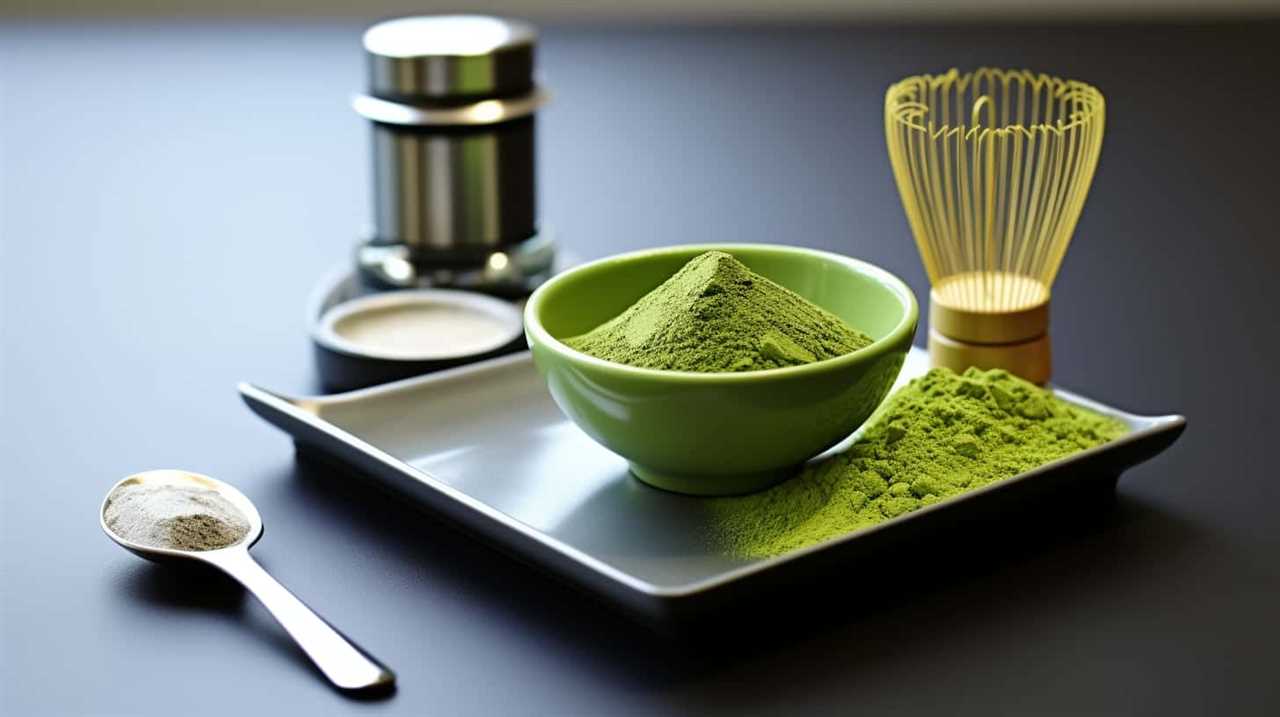
| Shade | Meaning |
|---|---|
| Vibrant Green | Represents high-quality ceremonial grade matcha |
| Bright Green | Indicates freshness and a balanced flavor |
| Dull Green | Suggests lower quality or older matcha |
Understanding the role of color in matcha allows tea enthusiasts to appreciate its beauty and make informed choices when selecting ceremonial grade tea powder. By paying attention to the color, one can ensure an authentic and enjoyable tea drinking experience.
Assessing the Aroma of Ceremonial Grade Tea Powder
We thoroughly assess the aroma of ceremonial grade tea powder by gently inhaling its fragrance. The aroma of high-quality tea powder should be fresh, vibrant, and inviting. The aroma should be delicate yet complex, with notes of grass, flowers, and a hint of sweetness. It shouldn’t have any off-putting or artificial smells.
When examining the appearance of the powder, we look for a vibrant and vibrant green color, indicating its freshness and quality.
Assessing the taste is also crucial in determining the quality of ceremonial grade tea powder. The aroma should be a reflection of the taste, with a smooth and balanced flavor profile. It should have a pleasant, lingering aftertaste that leaves you craving for more.
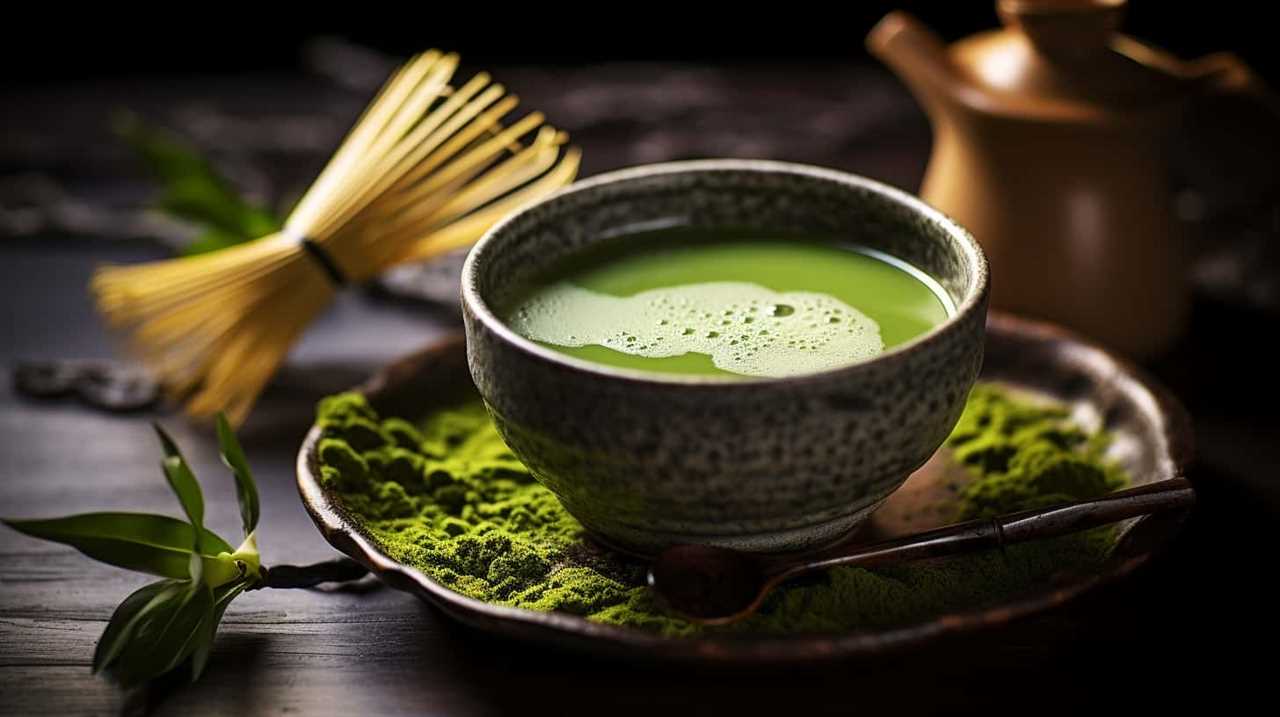
Examining the Texture and Consistency of Matcha
When it comes to examining the texture and consistency of matcha, there are two key points to consider: smoothness and graininess. Smooth matcha indicates a high-quality powder that has been finely ground, while grainy matcha may suggest a lower grade.
Additionally, the texture of matcha contributes to its mouthfeel, with a silky consistency often indicating a more refined tea powder.
Smooth Vs. Grainy Matcha
As we delve into the topic of examining the texture and consistency of matcha, it’s important to distinguish between smooth matcha and grainy matcha.
Smooth matcha refers to a fine, velvety powder that dissolves easily, resulting in a silky mouthfeel when consumed.
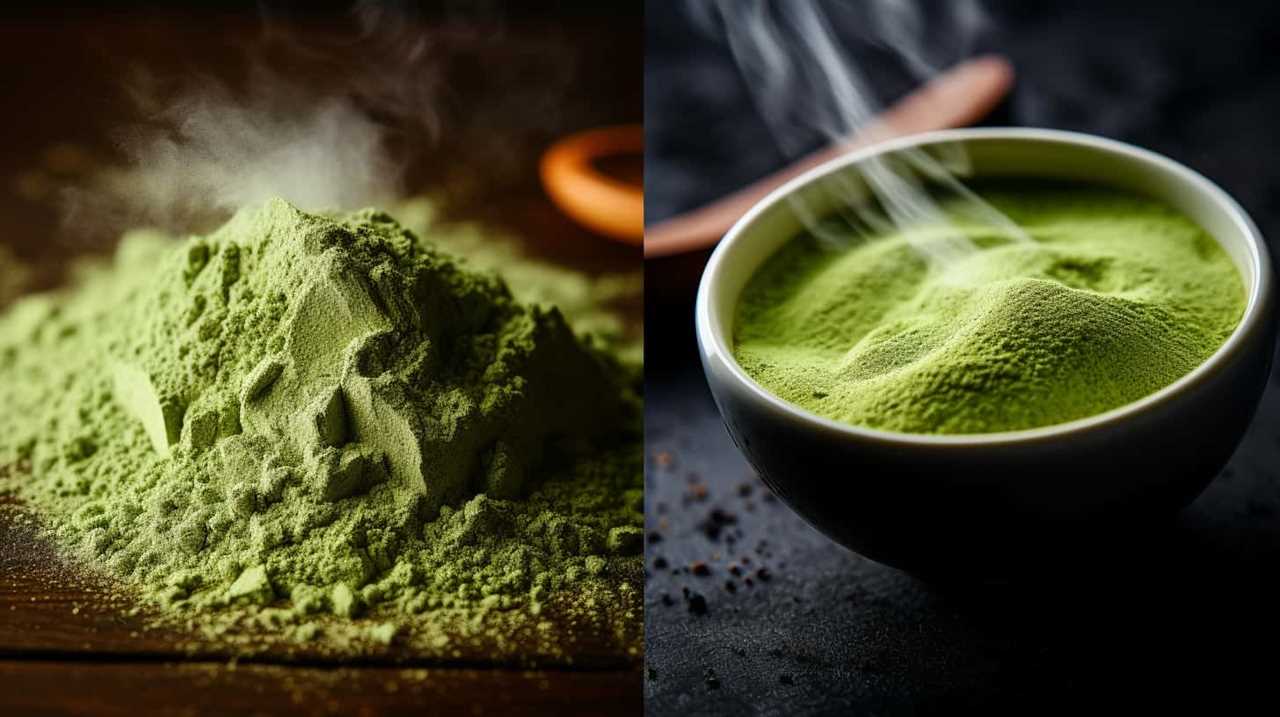
On the other hand, grainy matcha has a rougher texture, with noticeable particles that can create a slightly gritty sensation in the mouth.
When it comes to matcha preparation techniques, the smoothness of the final product can be influenced by factors such as the quality of the tea leaves, the grinding process, and the blending method.
To achieve a smooth matcha, it’s crucial to use high-quality ceremonial grade tea powder, ensure proper grinding techniques are employed, and employ a gentle blending motion.
By understanding the differences between smooth and grainy matcha, you can select a tea that meets your preferences and enjoy a truly satisfying matcha experience.

Now, let’s explore how the texture of matcha can indicate its silky mouthfeel.
Silky Mouthfeel Indication
To understand the silky mouthfeel of matcha, let’s examine its texture and consistency. When it comes to matcha, texture plays a crucial role in delivering a satisfying mouthfeel experience. Ceremonial grade matcha, known for its exceptional quality, boasts a smooth texture that glides effortlessly across the palate.
As we sip on a cup of finely ground matcha powder, we can appreciate its velvety consistency, which is a result of careful processing and meticulous grinding techniques. The smoothness of the matcha is a testament to the skill and expertise of the tea artisans who’ve crafted this ceremonial grade powder.
This delightful mouthfeel experience enhances the overall enjoyment of the tea, making it a truly luxurious choice for tea connoisseurs seeking mastery in their tea-drinking journey.

Evaluating the Flavor Profile of Ceremonial Grade Matcha
We thoroughly assess the flavor profile of ceremonial grade matcha to ensure its quality and authenticity. Evaluating the texture of ceremonial grade matcha is crucial in understanding its overall quality. We look for a smooth and creamy texture that coats the palate with each sip, indicating a well-ground and finely powdered matcha.
Additionally, we pay close attention to the aroma of the tea powder. A vibrant and fresh aroma, reminiscent of freshly cut grass or seaweed, is a sign of high-quality ceremonial grade matcha.
Furthermore, we evaluate the flavor notes present in the matcha. A balanced combination of umami, sweetness, and slight bitterness creates a complex and enjoyable taste experience. Lastly, we consider the lingering aftertaste, which should be smooth and pleasant.
By thoroughly evaluating these aspects, we can confidently determine the quality and authenticity of ceremonial grade matcha.

Now, let’s delve into how to determine the origin of ceremonial grade tea powder.
How to Determine the Origin of Ceremonial Grade Tea Powder
When it comes to choosing ceremonial grade tea powder, one crucial factor to consider is its authenticity. Determining the origin of the tea is key in ensuring its quality and flavor.
By tracing the geographical source of the tea powder, we can gain insight into the specific conditions in which it was grown, harvested, and processed. This information is essential in understanding the unique characteristics that the tea powder possesses.
Ultimately, understanding the origin of the tea powder allows us to make an informed decision about which ceremonial grade tea powder to choose. It helps us ensure that we are selecting a high-quality product that meets our preferences and expectations.

Authenticity of Tea Powder
One way to determine the origin of ceremonial grade tea powder is by examining its packaging and labeling for specific indicators. When it comes to the authenticity of tea powder, there are several key factors to consider:
- Organic Certification: Look for labels indicating that the tea powder is certified organic. This ensures that it has been grown without the use of synthetic pesticides or fertilizers, promoting a more natural and sustainable tea production process.
- Country of Origin: Pay attention to where the tea powder is sourced from. Different countries have distinct tea-growing regions known for their unique flavors and quality.
- Sustainability Practices: Check if the tea powder is produced using sustainable practices, such as responsible water usage, energy conservation, and waste management. This helps support environmentally friendly tea production.
- Direct Trade: Look for indications that the tea powder is sourced through direct trade relationships, which promote fair wages and better working conditions for tea farmers.
- Authenticity Seals: Some tea powder brands include authenticity seals or certifications that guarantee the quality and origin of the product. These can provide additional reassurance of the tea’s authenticity and quality.
Tracing Tea’s Geographical Source
To determine the origin of ceremonial grade tea powder, we can trace its geographical source through various methods. By tracing tea’s historical roots and understanding the cultural significance of tea, we can uncover valuable information about its origin.
One effective method is through the use of labeling and packaging. Many reputable tea producers provide detailed information about the region where the tea was grown, allowing consumers to make informed choices. Additionally, conducting research and consulting knowledgeable experts can provide insights into specific tea-growing regions and their unique characteristics.
For a more comprehensive understanding, we can also consider the climate, soil conditions, and altitude of the tea-growing regions. These factors greatly influence the flavor and quality of the tea.

Understanding the geographical source of ceremonial grade tea powder is crucial in ensuring its authenticity and maintaining the highest standards of quality.
Transitioning into the next section, the significance of harvesting and processing methods…
The Significance of Harvesting and Processing Methods
Harvesting and processing methods play a crucial role in determining the quality and characteristics of ceremonial grade tea powder. To truly understand the significance of these techniques, let’s delve into some key aspects:
- Timing: The moment the tea leaves are plucked affects their flavor and aroma. Early spring harvests, known as first flush, are highly sought after for their delicate and vibrant flavors.
- Handpicking: Skilled tea artisans handpick the leaves, ensuring only the youngest and tenderest ones are selected. This meticulous process guarantees the finest quality tea powder.
- Shade-grown: Shade-grown tea leaves develop a deeper green color and possess a sweeter, more umami flavor. The shading technique involves covering the tea plants to reduce sunlight exposure.
- Steaming: To preserve the natural flavors and vibrant green color, the leaves are steamed immediately after picking. This process stops oxidation and locks in the tea’s freshness.
- Stone grinding: Traditional ceremonial grade tea powder is finely ground using granite stone mills, which ensures a smooth and velvety texture.
Understanding these harvesting and processing methods is crucial in appreciating the complexities of ceremonial grade tea powder.
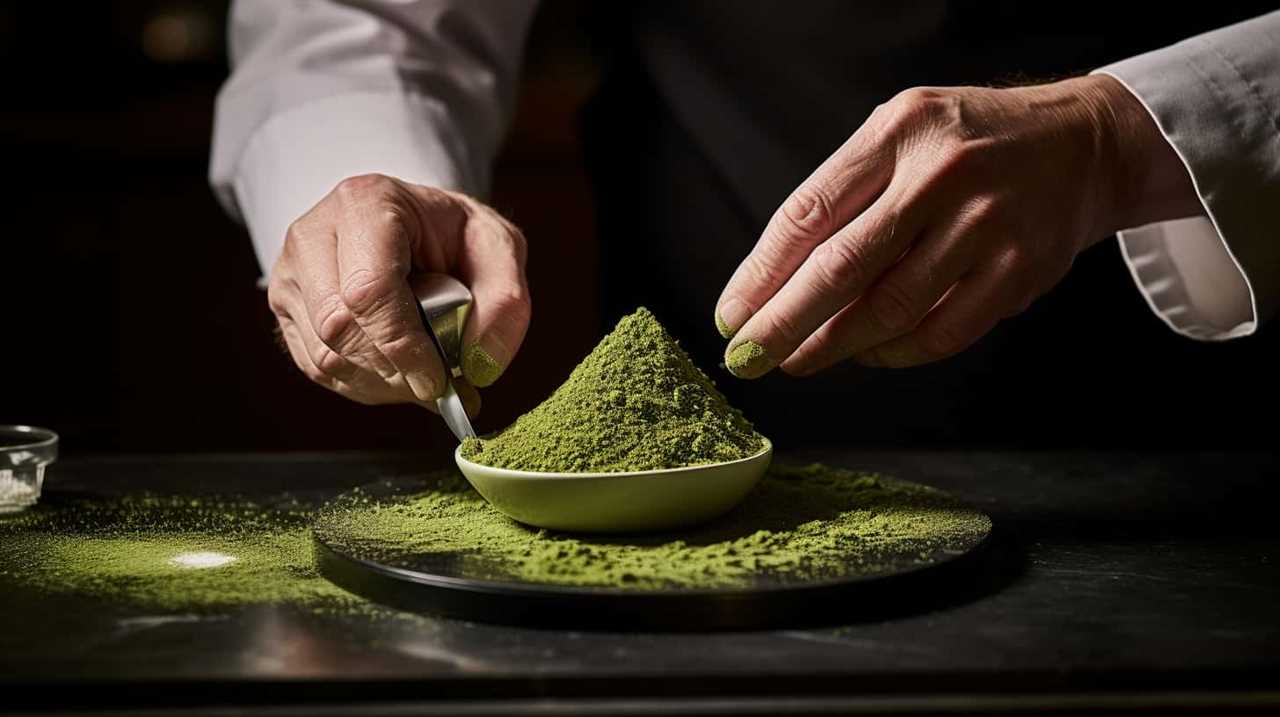
Now, let’s explore the different grades of matcha and what they mean.
Different Grades of Matcha and What They Mean
Let’s explore the various grades of matcha and their significance in choosing ceremonial grade tea powder. Understanding matcha grades is essential in selecting the perfect matcha for your tea ceremony. When it comes to matcha, there are several factors to consider before making a decision. To help you navigate through the options, here is a breakdown of the different matcha grades and what they mean:
| Grade | Description |
|---|---|
| Ceremonial | The highest quality matcha, made from young leaves with a vibrant green color and smooth taste. |
| Premium | A high-quality matcha, slightly less vibrant in color and flavor compared to ceremonial grade. |
| Culinary | Used for cooking and baking, culinary grade matcha is still of good quality but less expensive. |
| Bulk | This grade is typically used in cafes and restaurants for lattes and other matcha beverages. |
When choosing matcha, consider the intended use, taste preferences, and budget. Ceremonial and premium grades are best for drinking while culinary and bulk grades are suitable for cooking and blending. Understanding these matcha grades will help you make an informed decision and enjoy the perfect cup of matcha every time.
Packaging and Storage Tips for Ceremonial Grade Matcha
As we delve into the topic of packaging and storage tips for ceremonial grade matcha, it’s important to consider the impact these factors have on preserving the quality and flavor of this prized tea powder. Proper packaging and storage are crucial in maintaining the freshness and potency of ceremonial grade matcha.
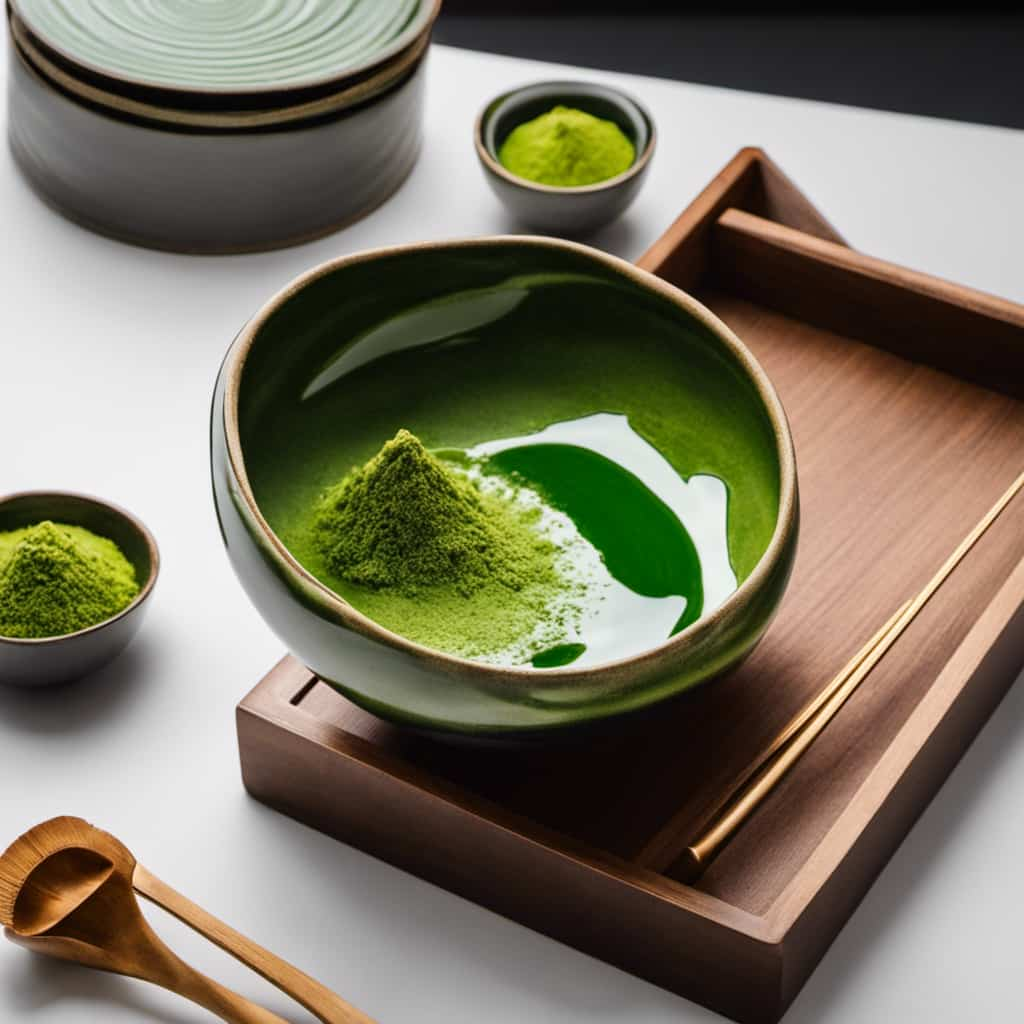
Here are some tips to help you store your matcha effectively:
- Use an airtight container: Transfer your matcha powder into an airtight container to prevent exposure to air and moisture, which can degrade its quality.
- Store in a cool, dark place: Keep your matcha away from direct sunlight and heat sources to avoid oxidation and flavor deterioration.
- Avoid contact with strong odors: Matcha easily absorbs odors, so store it away from strong-smelling spices or ingredients.
- Use it within 3-4 weeks: Matcha is best enjoyed when fresh, so try to consume it within a month of opening the package.
- Don’t freeze or refrigerate: Matcha should be stored at room temperature, as extreme cold or freezing temperatures can negatively affect its quality.
Expert Recommendations for Choosing Ceremonial Grade Tea Powder
To further enhance your understanding of ceremonial grade matcha, let’s now explore the expert recommendations for choosing this exceptional tea powder.
When it comes to selecting ceremonial grade matcha, color grading is an important factor to consider. The vibrant green color of the powder indicates its high quality and freshness. Look for matcha with a bright, emerald hue as it signifies a premium grade.
Additionally, consider the health benefits that the tea powder offers. Ceremonial grade matcha is known for its rich antioxidants, amino acids, and chlorophyll content, which contribute to its numerous health benefits such as increased energy, improved focus, and a strengthened immune system.
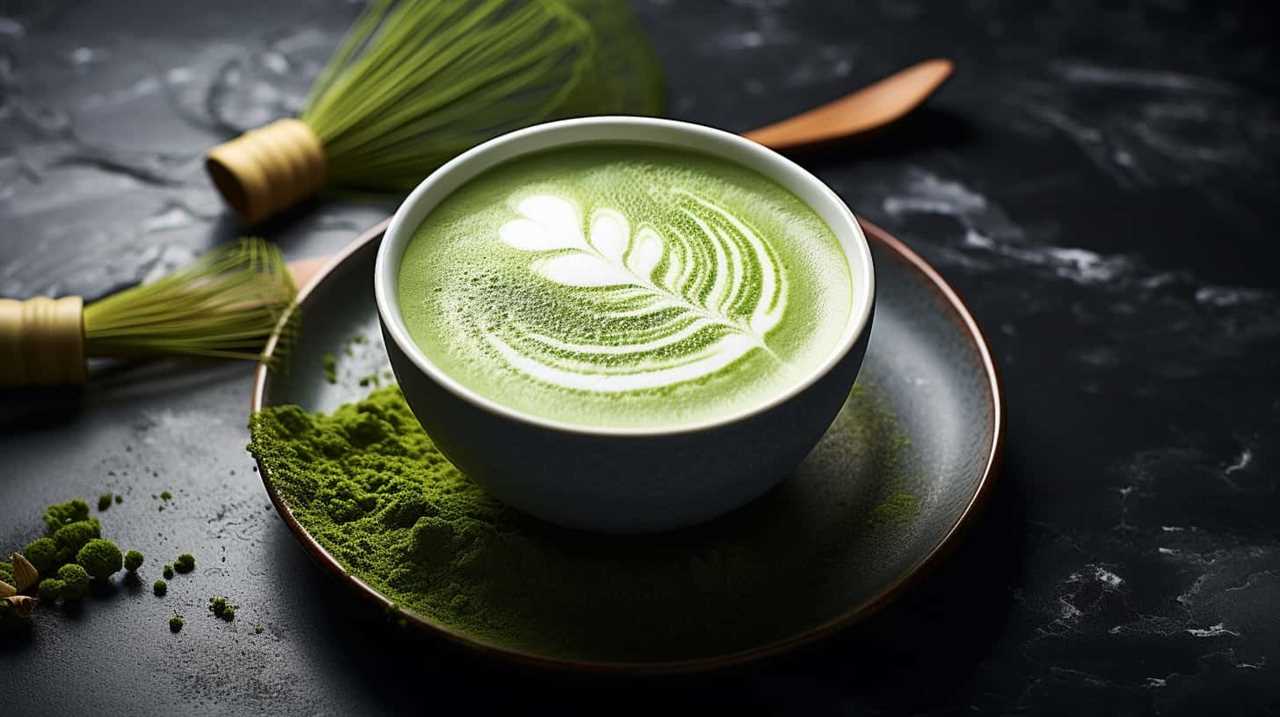
Frequently Asked Questions
How Does the Quality of Tea Leaves Affect the Taste of Ceremonial Grade Matcha?
The quality of tea leaves directly impacts the taste of ceremonial grade matcha. High-quality leaves result in a smoother, richer flavor, while lower-quality leaves may have a bitter or astringent taste.
What Are the Key Elements of the Traditional Japanese Tea Ceremony?
When it comes to the traditional Japanese tea ceremony, there are several key elements that make it a truly immersive experience. From the serene setting to the precise, ritualistic tea preparation, every aspect is carefully curated for a moment of pure tranquility.
Are There Specific Factors to Consider When Purchasing Ceremonial Grade Matcha?
When purchasing ceremonial grade matcha, there are several factors to consider. Quality, freshness, origin, and production methods are important considerations. These factors ensure a superior and authentic tea experience.
How Does the Color of Ceremonial Grade Matcha Indicate Its Quality?
When it comes to the color of ceremonial grade matcha, it serves as an indicator of its quality. The vibrant green hue suggests a higher grade, which in turn affects the taste and other factors.
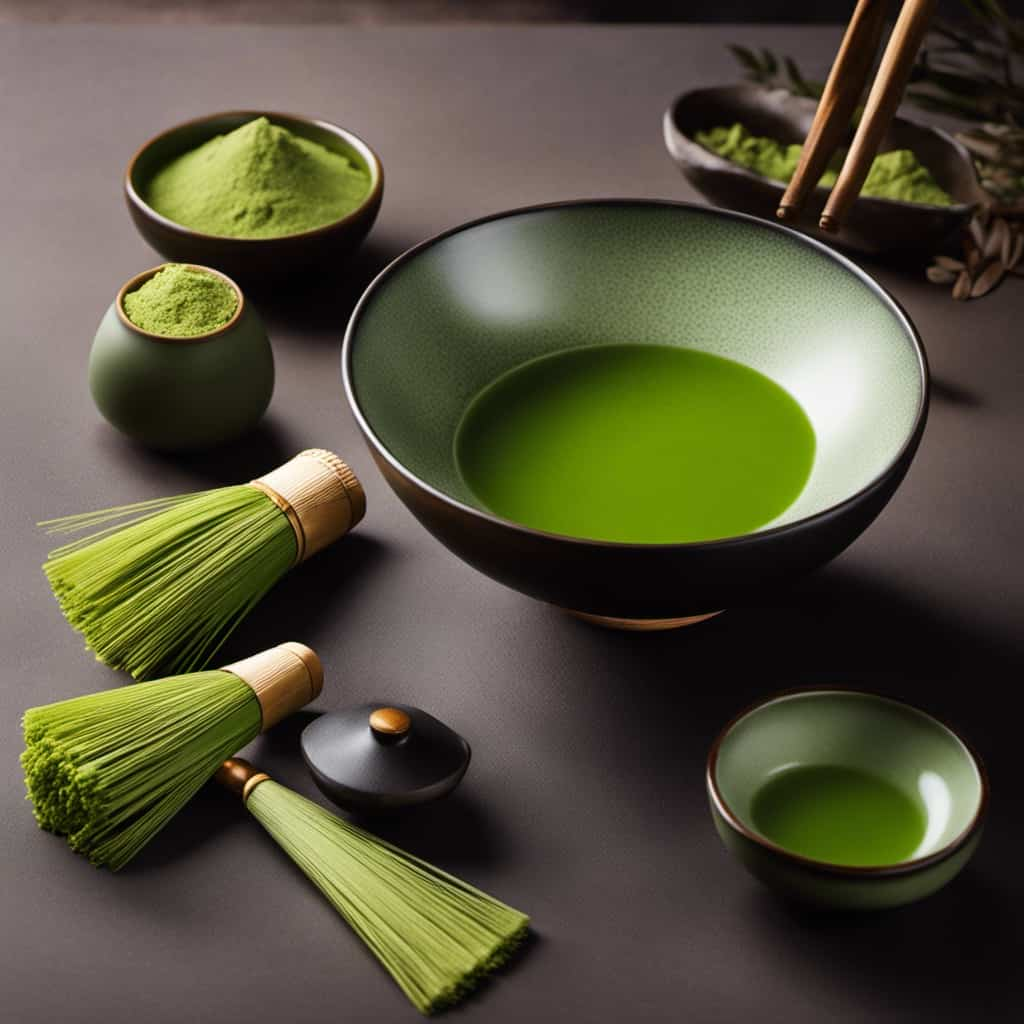
Can the Origin of Ceremonial Grade Tea Powder Be Determined by Certain Characteristics or Indicators?
When determining the origin of ceremonial grade tea powder, certain characteristics and indicators can be used. These include the region’s unique climate, soil composition, and cultivation practices, which all contribute to the tea’s distinct flavor and quality.
Conclusion
In conclusion, choosing ceremonial grade tea powder requires a deep understanding of its quality, traditional significance, and various factors such as color, harvesting, and processing methods.
By considering these factors and following expert recommendations, you can ensure that you’re selecting the highest quality matcha for your tea ceremonies.
So, are you ready to embark on a journey of discovering the exquisite world of ceremonial grade tea powder?
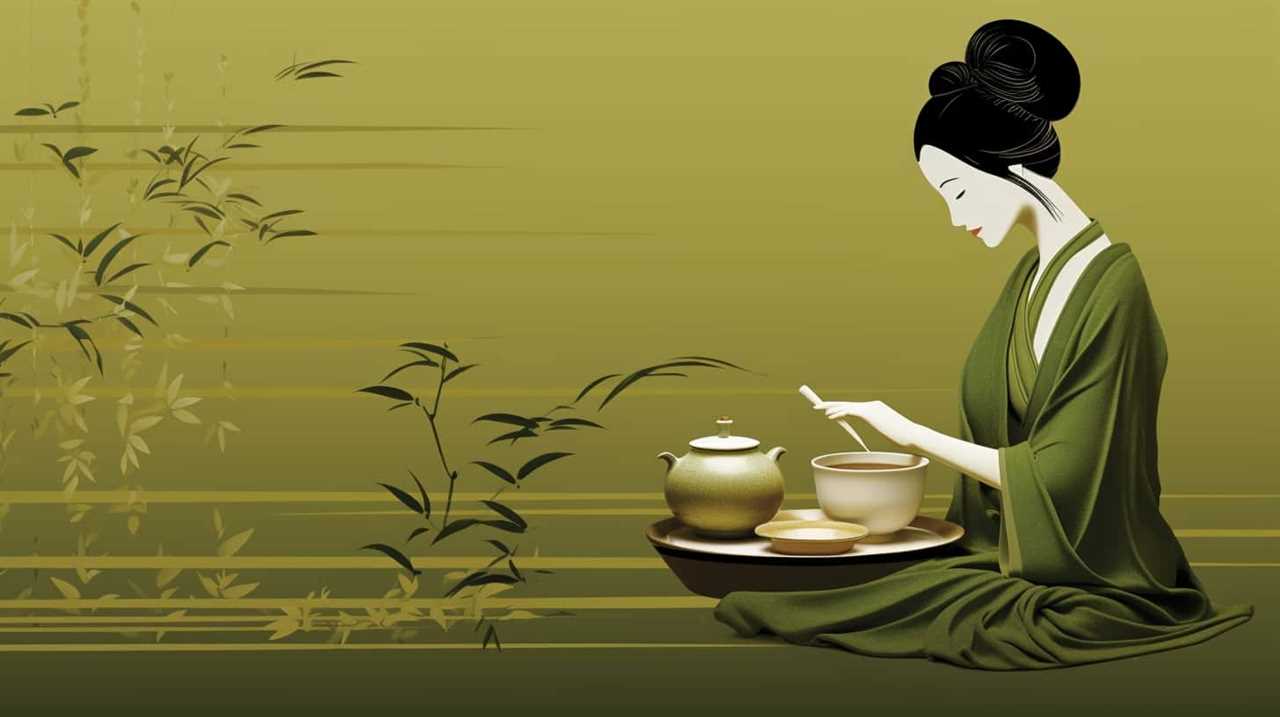
Justin is a seasoned author, coffee and tea enthusiast, and an essential member of the Cappuccino Oracle team. With a keen appreciation for the complexities of coffee, coffee alternatives, and tea, Justin has dedicated his professional career to exploring these realms and sharing his insights with readers worldwide.
Justin’s immersion in the world of coffee, coffee alternatives, and tea began at a young age, kindling a passion that extended beyond mere consumption. This love for these beverages led him to combine his talent for writing with his devotion to coffee and tea, bringing him to Cappuccino Oracle as a dedicated author.
Matcha
Unveiling The Mysteries Of Matcha: Insights On Its Origins, Production, And Quality

Have you ever been curious about the mysteries behind the rich and natural flavors of matcha? If so, get ready to join me on an adventure as we uncover the secrets of matcha, delving into its origins, production, and quality.
As a lover of all things tea, I have delved deep into the world of matcha, immersing myself in its rich history and intricate production process. From the shade-grown tea leaves to the meticulous grinding technique, every step is a labor of love that culminates in the velvety smooth powder we know as matcha.
Join me as we unravel the secrets behind this ancient Japanese tradition and discover why quality is key when indulging in this verdant elixir. We’ll explore the nuances of flavor, the importance of sourcing, and even delve into the fascinating world of other tea varieties.
So grab a cup, sit back, and let’s dive into the captivating world of matcha.
Key Takeaways
- Matcha tea is made from powdered green tea leaves and has a long and labor-intensive production process.
- Premium matcha is made from the first harvest in early spring, using the top 3 sprouts of the tea plant and ground tencha leaves.
- Cheaper matchas may skip some steps in the production process and are more suitable for matcha lattes.
- High-quality matcha is recommended for sparing consumption, as it has a smoother flavor and more health benefits compared to cheaper matchas.
What is matcha?
I’ve learned that matcha is a powdered green tea made from special tea leaves that are shaded before harvest, and it has a long and labor-intensive production process.
There are different types of matcha available, but the premium matcha is made from the first harvest in early spring, using only the top 3 sprouts of the tea plant. The leaves are then steamed, dried, and have their stems removed before being ground into a fine powder using a specialized mill made of granite.
It’s important to note that high-quality matcha is recommended for sparing consumption, as it has a complex production process that results in a smooth flavor. Matcha also offers various health benefits, such as being rich in antioxidants, boosting metabolism, and improving mental alertness.
Production process
The matcha production process involves shading the tea leaves before harvest and selecting the top three sprouts of the tea plant for premium matcha. Shading is a technique used to enhance the flavor and quality of the tea leaves. By covering the tea plants with shade, the leaves produce more chlorophyll and amino acids, resulting in a vibrant green color and a rich, umami taste.
After the shading period, only the top three sprouts of the tea plant are carefully handpicked for premium matcha. These selected leaves, known as tencha leaves, are then steamed, dried, and have their stems removed.
Finally, the tencha leaves are ground into a fine powder using a specialized granite mill. This process results in the smooth and concentrated matcha powder that we enjoy.
Quality and consumption
Let me tell you, indulging in high-quality matcha is like sipping a vibrant green elixir that awakens your taste buds and nourishes your body with its rich flavor and numerous health benefits. Matcha’s health benefits are truly remarkable. Packed with antioxidants, vitamins, and minerals, matcha is known to boost metabolism, enhance focus and concentration, and strengthen the immune system.
But not all matcha is created equal. Different grades of matcha exist, ranging from ceremonial grade to culinary grade. Ceremonial grade matcha is made from the highest quality tencha leaves and has a smooth, vibrant green color and a delicate, umami flavor. It is best enjoyed on its own, whisked with hot water.
On the other hand, culinary grade matcha is more affordable and is suitable for making matcha lattes, smoothies, and baked goods. Although it may have a slightly bitter taste and a duller color, it still provides health benefits.
So, whether you choose to indulge in high-quality ceremonial grade matcha or opt for the more affordable culinary grade, incorporating matcha into your routine is a delicious way to reap its health benefits.
Frequently Asked Questions
What are some popular ways to enjoy matcha besides drinking it as tea?
Besides drinking matcha as tea, some popular ways to enjoy it include indulging in matcha desserts like matcha ice cream, matcha cake, and matcha cookies. Additionally, matcha smoothies are a refreshing and healthy option.
Are there any specific health benefits associated with consuming matcha?
I’m no expert, but matcha is said to have potential health benefits. Some claim it can aid in weight loss due to its high antioxidant content and metabolism-boosting properties. However, more research is needed to confirm these claims.
How does the quality of matcha affect its flavor and overall experience?
The quality of matcha directly affects its flavor and overall experience. Higher quality matcha, made from carefully selected leaves and processed with precision, offers a smoother and more vibrant flavor, while lower quality matcha may have a less appealing taste and color.
Can matcha be used in cooking or baking?
"Where there’s matcha, there’s a way! Matcha can be used in a variety of cooking and baking recipes, adding a vibrant green color and a unique earthy flavor to dishes like matcha desserts."
Are there any specific tips or techniques for properly preparing matcha tea at home?
To properly prepare matcha tea at home, start by sifting the matcha powder to remove any clumps. Then, choose water at around 175°F to 180°F for the best flavor. Gradually add water to the matcha and whisk in a "W" or "M" motion until frothy. Enjoy!
Conclusion
In conclusion, matcha tea is not just a beverage, but a rich and fascinating tradition that has evolved over centuries.
From its origins in Japan to its intricate production process, matcha is a labor of love.
The quality of matcha is crucial, as the steps taken in its production directly impact its flavor and aroma.
Whether you’re a matcha connoisseur or a beginner, there is a matcha tea out there for you.
So, why not indulge in a cup of this vibrant green elixir and experience the magic of matcha for yourself? It’s a journey worth embarking on!
Arf, an author and an innovative enthusiast of coffee, coffee alternatives, and tea, plays a crucial role as a contributor to the esteemed Cappuccino Oracle platform. Renowned for his curiosity and passion for these captivating beverages, Arf has carved out a unique space for himself in the world of exploration and writing. He realized that coffee, coffee alternatives, and tea are not mere drinks to keep one awake, but universes of flavors and stories waiting to be explored.
Arf’s articles for Cappuccino Oracle blend meticulous research with personal experiences, providing readers with an in-depth understanding of various types of coffee, coffee alternatives, and tea, along with their unique characteristics, cultures, and histories. His honest reviews and engaging narratives guide readers on their own journeys, helping them discover their preferences and find their perfect brew.
Matcha
Unveiling The Truth Behind Starbucks’ Matcha: A Disappointing Blend

Being a lover of tea, I was eager to sample Starbucks’ matcha beverages, anticipating a flavorful and genuine taste. However, to my dismay, I found that it was a subpar mixture of inexpensive green tea powder and an excessive amount of sugar. This was a stark contrast to the customary matcha experience that I had grown accustomed to.
The use of low-quality matcha by Starbucks is driven by the need for mass production and a consistent taste across all locations. But in this pursuit, they have sacrificed the true essence of matcha. Authentic matcha production involves meticulous steps to ensure a high-quality and flavorful product, steps that Starbucks seems to skip.
The result is a matcha latte packed with 32 grams of sugar, equivalent to a can of soda, and a whopping 240 calories. It’s time to unveil the truth behind Starbucks’ matcha and explore better options for a truly satisfying tea experience.
Key Takeaways
- Starbucks uses a cheap green tea powder for their matcha drinks, which may not even be considered matcha.
- The cheap matcha powder is mixed with a lot of sugar, negating the health benefits and undermining the quality of the tea.
- Starbucks’ matcha latte contains a high amount of sugar, similar to a can of soda, and has a significant number of calories.
- To have a better matcha experience, it is recommended to explore premium, first harvest matcha made by talented farmers in Japan and to try different matcha options to find preferred taste.
What is Starbucks Matcha?
Starbucks Matcha is a cheap green tea powder mixed with a high amount of sugar, which not only undermines the health benefits of matcha but also fails to deliver the natural, great-tasting flavor of authentic matcha tea.
The ingredients used in Starbucks matcha include low-quality green tea powder that is likely produced on a large scale. Unlike traditional matcha production methods, Starbucks skips certain steps to save time and money. These steps, such as shading the tea plants to reduce bitterness and selecting the top leaves for their flavor and nutrients, are crucial in creating high-quality matcha.
Instead, Starbucks opts for a blend of cheap green tea powder mixed with sugar, resulting in a dull and bitter flavor. This disappointing blend of ingredients does not live up to the standards of true matcha tea.
Quality vs. Cheap Matcha
Indulging in high-quality matcha is like savoring a delicate melody that dances on your taste buds, while settling for cheap matcha is akin to a discordant symphony that leaves a bitter aftertaste. When it comes to matcha, quality matters. Traditional matcha production is an art that requires time, patience, and attention to detail. The importance of shading the tea plants, selecting the top leaves, and using a stone mill to grind the leaves into a fine powder cannot be overstated. These steps not only enhance the flavor but also preserve the health benefits of matcha. High-quality matcha is rich in antioxidants, boosts metabolism, and promotes a sense of calm. On the other hand, cheap matcha often lacks these qualities as it skips crucial steps and is mixed with sugar and other additives. Don’t settle for a subpar matcha experience; choose high-quality matcha for its exceptional taste and health benefits.
| Traditional Matcha Production |
|---|
| Shading the tea plants |
| Selecting the top leaves |
| Grinding with a stone mill |
The importance of traditional matcha production cannot be overstated. These steps not only enhance the flavor but also preserve the health benefits of matcha. High-quality matcha is rich in antioxidants, boosts metabolism, and promotes a sense of calm. On the other hand, cheap matcha often lacks these qualities as it skips crucial steps and is mixed with sugar and other additives. Don’t settle for a subpar matcha experience; choose high-quality matcha for its exceptional taste and health benefits.
Recommendations for Better Matcha
Exploring different matcha options can lead to a better matcha experience. When it comes to matcha, not all options are created equal. While Starbucks may offer a convenient matcha latte, there are alternative options that provide a more authentic and higher quality experience.
Premium matcha, specifically first harvest matcha, is made by talented farmers in Japan and can be enjoyed plain, without the need for excessive sugar or additives. By choosing premium matcha, you can reap the full benefits that matcha has to offer, such as its high antioxidant content and potential health benefits.
Additionally, exploring different types of matcha, such as Japanese black tea, can expand your taste palate and introduce you to new and exciting flavors. So, why settle for a disappointing blend when there are better matcha options out there waiting to be explored?
Frequently Asked Questions
How is Starbucks matcha different from traditional matcha?
Starbucks matcha differs from traditional matcha in terms of quality and taste. One interesting statistic is that Starbucks’ matcha latte contains 32 grams of sugar, similar to a can of soda, which undermines the health benefits of matcha.
What are the health benefits of matcha and how do they differ between Starbucks matcha and premium matcha?
The health benefits of matcha include high levels of antioxidants, increased energy, and improved focus. However, Starbucks matcha quality is compromised due to the use of cheap powder mixed with sugar, negating these benefits.
Can you customize the sweetness level of Starbucks matcha drinks?
Yes, you can customize the sweetness level of Starbucks matcha drinks. They offer popular matcha drink variations like matcha latte and matcha frappuccino, allowing customers to choose the amount of sweetener they prefer.
Are there any alternative options for matcha drinks at Starbucks?
Yes, there are alternative options for matcha drinks at Starbucks. However, it’s important to note that the taste may not be comparable to traditional matcha. Exploring different matcha options and Japanese black tea can provide a better experience.
What are the steps involved in producing high-quality matcha and how does Starbucks’ matcha production differ?
Starbucks’ matcha production process differs from traditional matcha production in Japan. High-quality matcha involves shading the tea plants, selecting the top leaves, steaming, drying, and grinding them. However, Starbucks skips these steps, resulting in a lower quality and less authentic matcha experience.
Conclusion
In conclusion, after delving into the truth behind Starbucks’ matcha, it’s clear that their blend falls short of expectations. The use of cheap green tea powder mixed with excessive sugar dilutes any potential health benefits and fails to deliver an authentic matcha experience.
To truly enjoy the rich and flavorful taste of matcha, it’s recommended to explore premium, first harvest options crafted by skilled Japanese farmers. Don’t settle for subpar matcha; treat yourself to a tea experience that’ll leave your taste buds dancing with delight.
Arf, an author and an innovative enthusiast of coffee, coffee alternatives, and tea, plays a crucial role as a contributor to the esteemed Cappuccino Oracle platform. Renowned for his curiosity and passion for these captivating beverages, Arf has carved out a unique space for himself in the world of exploration and writing. He realized that coffee, coffee alternatives, and tea are not mere drinks to keep one awake, but universes of flavors and stories waiting to be explored.
Arf’s articles for Cappuccino Oracle blend meticulous research with personal experiences, providing readers with an in-depth understanding of various types of coffee, coffee alternatives, and tea, along with their unique characteristics, cultures, and histories. His honest reviews and engaging narratives guide readers on their own journeys, helping them discover their preferences and find their perfect brew.
Matcha
The Ultimate Guide To Using Chashaku: Your Matcha Essential

Being a lover of matcha, I am aware that the crucial factor in achieving the perfect matcha bowl is the equipment we utilize. When it comes to preparing matcha, there is one tool that is particularly essential: the chashaku.
This bamboo spoon, with its elegant design and precise measurements, is the secret weapon of matcha lovers worldwide. In this ultimate guide, I will take you on a journey through the history and evolution of the chashaku, and show you how to use it like a pro.
From its origins as a metal or ivory scoop to its modern-day incarnation in bamboo, the chashaku has come a long way. With its 48° bend and 18mm length, it effortlessly scoops the perfect amount of matcha from its container.
So grab your chashaku and get ready to elevate your matcha game to new heights. Let’s dive in and discover the wonders of this matcha essential.
Key Takeaways
- Chashaku is a bamboo spoon used to scoop matcha powder in the Japanese tea ceremony and by matcha lovers worldwide.
- Chashaku is one of the three important tea utensils used in the tea ceremony and is about 18mm in length with a 48° bend at the end for scooping.
- Chashaku is made of bamboo to avoid negative reactions with matcha powder and is a great measurement tool for matcha powder.
- Two scoops of chashaku is the standard amount for a bowl of matcha tea, and it is easy to maneuver in matcha tins or natsume due to its small size.
What is Chashaku?
Chashaku is a bamboo spoon used to scoop matcha powder, and it’s one of the three important tea utensils used in the Japanese tea ceremony.
Made from a single piece of bamboo, this elegant tool has a long history dating back to the Muromachi period in Japan. Originally crafted from metal or ivory, chashaku evolved to be made of bamboo due to its natural properties and to avoid any negative reactions with matcha powder.
The design of chashaku is both functional and beautiful, with a length of about 18mm and a 48° bend at the end for easy scooping. There are different styles of chashaku scoops, each with its own unique shape and characteristics. The back of the chashaku has a rough texture, while the face is smooth and sleek.
Whether you’re a matcha lover or a tea ceremony enthusiast, using a chashaku adds a touch of authenticity and tradition to your matcha preparation.
History and Evolution
During the Muromachi period in Japan, the chashaku spoon evolved from being made of metal or ivory to its current bamboo form, which is about 18mm in length and has a 48° bend at the end for easier scooping. The history and evolution of the chashaku is a testament to its significance in Japanese tea ceremonies and its cultural importance in matcha preparation.
| The significance of chashaku in Japanese tea ceremonies | The cultural importance of chashaku in matcha preparation |
|---|---|
| Chashaku is one of the three important tea utensils used in the tea ceremony. | Chashaku is a great measurement tool for matcha powder. |
| Chashaku originated in Japan during the Muromachi period. | Chashaku’s small size allows for easy maneuvering in matcha tins or natsume. |
| Originally made of metal or ivory, chashaku evolved to be made of bamboo. | Chashaku is made from a single piece of bamboo and shaped with a bend for the scoop. |
| Chashaku is made of bamboo to avoid negative reactions with matcha powder. | The back of chashaku has a rough texture, while the face is smooth and sleek. |
The chashaku’s role in Japanese tea ceremonies cannot be understated. It is one of the three essential utensils used in the tea ceremony, alongside the chawan (tea bowl) and chasen (tea whisk). The chashaku’s small size and precise measurement make it the perfect tool for scooping matcha powder. Its evolution from metal or ivory to bamboo shows the cultural importance placed on this utensil. The chashaku’s design, with its gentle bend and smooth face, allows for easy and graceful scooping of matcha. Using the chashaku is not only practical but also a way to honor the centuries-old tradition of matcha preparation.
How to Use Chashaku
To use the chashaku, I simply hold it like a pencil and dip the scoop into the matcha container. Then, I carefully lift the chashaku scoop out and place it over the matcha bowl to dump the powder.
It’s a simple and elegant technique that ensures the perfect amount of matcha every time.
But did you know that there are alternative ways to use the chashaku? Some matcha lovers prefer to use a teaspoon or a regular spoon to scoop their matcha powder. While these alternatives may work in a pinch, they don’t offer the same precision and authenticity as the chashaku.
The chashaku’s unique design and size make it the ideal tool for measuring matcha powder. Plus, using the chashaku adds a traditional touch to the matcha preparation process, enhancing the overall experience.
So why settle for anything less? Embrace the chashaku and elevate your matcha game to the next level.
Frequently Asked Questions
What are the different types of materials used to make chashaku besides bamboo?
There’s something truly magical about the chashaku, the bamboo spoon that gracefully scoops matcha powder. While bamboo is the traditional material, chashaku can also be made from metal or ivory, although these alternatives are less common.
Can chashaku be used to scoop other powders besides matcha?
Yes, chashaku can be used to scoop other powders besides matcha. However, it is primarily designed for scooping matcha powder and is most commonly used in Japanese tea ceremonies. To properly clean and care for a chashaku, it is recommended to wipe it with a dry towel or tissue to avoid water damage. The chashaku is a versatile tool with different uses in the tea ceremony, making it an essential item for matcha lovers.
How long does a chashaku typically last before it needs to be replaced?
A chashaku typically lasts for a long time, but the lifespan can vary depending on the material. Bamboo chashaku is the most common and durable option, while metal or ivory may wear down over time. Proper care involves cleaning with a dry towel or tissue to avoid water damage.
Can chashaku be used with different types of matcha bowls or is it specific to a certain style?
Absolutely! Chashaku can be used with various types of matcha bowls, adapting to different styles. Its small size and unique design make it perfect for scooping matcha powder and adding a touch of elegance to your matcha preparation.
Are there any alternative utensils that can be used in place of chashaku for scooping matcha powder?
Yes, there are alternative utensils for scooping matcha powder, such as a teaspoon or a small spoon. However, using a chashaku has its benefits. Its unique design allows for precise measurements and easy maneuvering in matcha tins.
Conclusion
In conclusion, using chashaku isn’t just a practical way to measure and scoop matcha powder, but it’s also an essential tool for embracing the art and tradition of the Japanese tea ceremony.
While some may argue that using a regular spoon can achieve the same result, chashaku offers a unique experience that connects us to centuries of tea culture. Imagine holding the slender bamboo spoon, feeling the weight of tradition in your hand, and delicately scooping the vibrant green matcha powder.
It’s a sensory journey that brings us closer to the beauty and mindfulness of matcha preparation. So, embrace the chashaku, and let it elevate your matcha experience to new heights.
Arf, an author and an innovative enthusiast of coffee, coffee alternatives, and tea, plays a crucial role as a contributor to the esteemed Cappuccino Oracle platform. Renowned for his curiosity and passion for these captivating beverages, Arf has carved out a unique space for himself in the world of exploration and writing. He realized that coffee, coffee alternatives, and tea are not mere drinks to keep one awake, but universes of flavors and stories waiting to be explored.
Arf’s articles for Cappuccino Oracle blend meticulous research with personal experiences, providing readers with an in-depth understanding of various types of coffee, coffee alternatives, and tea, along with their unique characteristics, cultures, and histories. His honest reviews and engaging narratives guide readers on their own journeys, helping them discover their preferences and find their perfect brew.
-

 Americano3 weeks ago
Americano3 weeks agoHow to Make Americano With Moka Pot
-

 Americano4 weeks ago
Americano4 weeks agoHow to Make an Americano in a French Press
-

 Americano6 days ago
Americano6 days agoHow to Make Korean Iced Americano
-

 Americano3 weeks ago
Americano3 weeks agoHow to Make Iced Americano With Instant Coffee
-

 Americano3 weeks ago
Americano3 weeks agoWhat to Add to an Americano at Starbucks
-

 Americano4 weeks ago
Americano4 weeks agoHow to Make Americano With a Nespresso Machine
-

 Americano3 weeks ago
Americano3 weeks agoHow to Make Americano With Bialetti
-

 Americano3 weeks ago
Americano3 weeks agoHow to Make Dutch Bros Americano

















